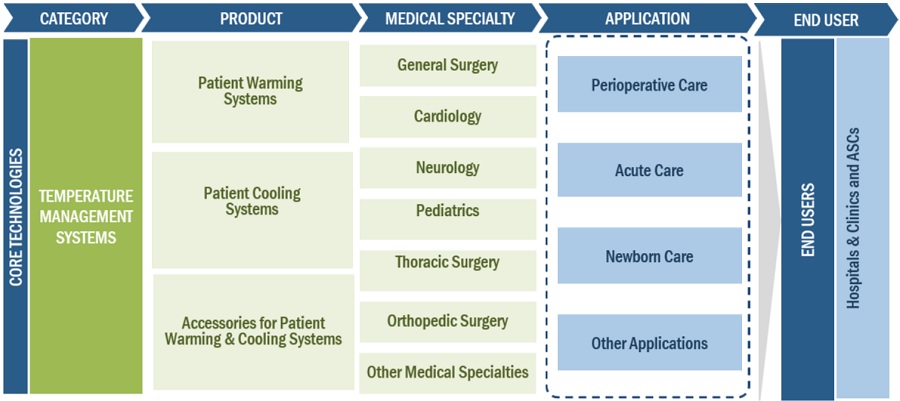Temperature management systems play a crucial role in modern healthcare across various medical specialties, including cardiology, neurology, pediatrics, and orthopedics. These systems are designed to regulate body temperature during critical phases of medical treatment, ensuring optimal patient outcomes. As technological advancements continue to enhance these systems, their adoption and integration into medical practices are expected to grow significantly. This article explores the temperature management systems market size across these specific medical specialties, highlighting key trends, drivers, and future projections.
Temperature Management Systems Market Size by Medical Speciality (Cardiology, Neurology, Pediatrics, Orthopedics) & Size – Global Forecast to 2028
Temperature management systems market in terms of revenue was estimated to be worth $3.0 billion in 2023 and is poised to reach $3.9 billion by 2028, growing at a CAGR of 4.9%
Download a PDF Brochure: https://www.marketsandmarkets.com/pdfdownloadNew.asp?id=141546773
Understanding Temperature Management Systems
Temperature management systems, often referred to as thermal regulation devices or hypothermia systems, are utilized in healthcare settings to control a patient’s body temperature. These systems are employed in a range of medical procedures, including surgeries, post-operative care, and treatment of various medical conditions where precise temperature control is critical for patient recovery.
The primary function of these systems is to prevent hypothermia (low body temperature) or hyperthermia (high body temperature), both of which can have detrimental effects on patients undergoing medical interventions. By maintaining a stable body temperature within a narrow range, these systems contribute significantly to reducing complications and improving overall patient outcomes.
Market Dynamics Across Medical Specialties
1. Cardiology:
Cardiac surgeries often involve the use of temperature management systems to maintain optimal conditions during procedures such as coronary artery bypass grafting (CABG) and valve replacement surgeries. The increasing prevalence of cardiovascular diseases and the growing number of cardiac procedures globally are key drivers for the adoption of these systems in cardiology.
2. Neurology:
In neurology, temperature management systems are crucial for patients undergoing treatments for traumatic brain injuries, stroke, and neurological surgeries. These systems help in managing intracranial pressure and minimizing secondary brain damage by controlling cerebral temperature. As advancements in neurosurgical techniques continue, the demand for precise temperature management solutions is expected to rise.
3. Pediatrics:
Temperature management is critical for infants and children undergoing surgical procedures, as their ability to regulate body temperature is less efficient compared to adults. Pediatric-specific temperature management systems are designed to cater to the unique needs of young patients, ensuring safety and efficacy during surgical interventions and critical care.
4. Orthopedics:
In orthopedic surgeries, maintaining perioperative normothermia (normal body temperature) is essential for optimizing surgical outcomes and reducing the risk of infections and complications. Temperature management systems are increasingly utilized in joint replacement surgeries, spine surgeries, and trauma cases to support patient recovery and rehabilitation.
Market Size and Growth Factors
The global market for temperature management systems is experiencing significant growth, driven by several factors:
- Technological Advancements: Continuous innovations such as closed-loop systems, non-invasive temperature monitoring, and precise control algorithms enhance the effectiveness and safety of temperature management systems.
- Increasing Surgical Procedures: The rising number of surgeries across all medical specialties, driven by aging populations and improvements in healthcare infrastructure, directly boosts the demand for temperature management systems.
- Awareness and Adoption: Healthcare providers increasingly recognize the benefits of temperature management in improving patient outcomes, leading to higher adoption rates in both developed and developing regions.
Future Projections and Opportunities
Looking ahead, the temperature management systems market is poised for substantial growth:
- Expansion in Emerging Markets: Greater healthcare expenditure in emerging economies, coupled with increasing access to advanced medical technologies, presents significant opportunities for market expansion.
- Integration of AI and Data Analytics: The incorporation of artificial intelligence (AI) and data analytics into temperature management systems allows for real-time monitoring and predictive analytics, further enhancing their utility and adoption.
- Focus on Patient Comfort and Safety: Future innovations are likely to focus on improving patient comfort during temperature management, reducing the need for sedation and minimizing the risk of adverse effects.
Conclusion
In conclusion, temperature management systems are integral to modern medical practices across various specialties, ensuring precise control of body temperature for improved patient care and outcomes. The market for these systems continues to grow driven by technological advancements, increasing surgical procedures, and heightened awareness among healthcare providers. As innovation continues to drive the evolution of temperature management systems, their role in enhancing patient safety and recovery is expected to become even more pronounced in the years to come.

Leave a comment